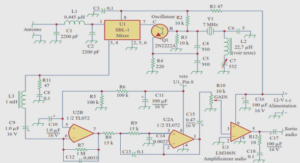Application au transfert radiatif
Abstract This paper presents radiative transfer calculations performed over Niamey in the UV-Visible range over the period 26th January – 1st February 2006 during the African Multidisciplinary Monsoon Analysis (AMMA) international program. Climatic effects of aerosols along the vertical column have required an accurate determination of their optical properties, which are presented in for a variety of instrumented platforms: Ultralight aircraft, Facility for Airborne Atmospheric Measurements (FAAM) research aircraft, AERONET station. Measurements highlighted the presence of a multi-layered structure of mineral dust located below and biomass-burning particles in the more elevated layers. Radiative forcing was affected by both the scattering and absorption effects governed by the aerosol complex refractive index (ACRI). The best agreement between our results and AERONET optical thicknesses, ground-based extinction measurements and NO2 photolysis rate coefficient was found using the synergy between all the instrumented platforms. The corresponding averaged ACRI at 355 nm were 1.53 (±0.04) – 0.047i (±0.006) and 1.52 (±0.04) – 0.008i (±0.001) for biomass-burning and mineral dust aerosols, respectively. Biomass-burning aerosols were characterized by single-scattering albedo ranging from 0.78 to 0.82 and asymmetry parameter ranging from 0.71 to 0.73. For dust aerosols, single-scattering albedo (asymmetry parameter) ranged from 0.9 to 0.92 (0.73 to 0.75). The solar energy 1. Introduction In contrast to the radiative forcing attributed to greenhouse gases, which may be estimated to a reasonably high degree of accuracy, the uncertainties related to aerosol radiative forcings remain very large. Hence, aerosol particles have received an increasing amount of attention in the recent years.
Scattering and absorption by aerosols have a significant impact on the energy budget of the atmosphere (Alpert et al., 1998), as well as on the surface (Fouquart et al., 1987). They reduce the solar radiative flux at the surface (Charlson et al., 1992), can limit surface evaporation and surface heat fluxes, and may modify large-scale atmospheric circulations as shown during the Indian Ocean experiment (INDOEX, Ramanathan et al., 2001; Léon et al., 2005). They also influence the climate altering the radiative properties and lifetime of clouds when particles act as Cloud Condensation Nuclei (Twomey et al., 1984). Atmospheric dynamics and convection can therefore be affected by aerosol (Ackerman et al., 2000). Assessing their influence is made complex by the high spatial and temporal variability of aerosol physical, chemical, and optical properties. This problem arises mainly due to diverse range of aerosol sources and their short residence times in the atmosphere. Among all sources of atmospheric particles, Western Africa is the world’s largest source of biomass burning aerosols (Andreae and Merlet, 2001) and mineral dust (Prospero et al, 2002). The regional impacts of mineral dust events have been studied, especially over sea areas, in previous multi-disciplinary campaigns involving ground-based monitoring, research aircraft,
Application au transfert radiatif
A Vaisala meteorological probe type PTU200 was used to measure the temperature, the relative humidity, and the atmospheric pressure. In addition, a global positioning system manufactured by Trimble was used to measure the location of the ULA (with accuracies of 15 and 10 m for vertical and horizontal positions, respectively), and an artificial horizon (electronic flight information system) manufactured by Dynon Avionics was used to locate the lidar line of sight in the three dimensions of space, with an accuracy close to 0.5°.
from 11th January to 3rd February. All flights started and ended at Niamey International Airport. The aircraft performed 13 flights within the vicinity of Niamey. It contains a comprehensive suite of instruments measuring aerosol, cloud, chemical tracers, solar and terrestrial radiative fluxes and standard meteorological variables that are described in Johnson et al. (2008a) and summarized below. Aerosol size distributions were measured by the Passive Cavity Aerosol Spectrometer Probe 100X (PCASP), mounted externally under the aircraft wing and sizing aerosols with radii in the range 0.05 – 1.5 µm. The PCASP is calibrated using latex spheres of known sizes. The refractive index of latex (1.58) differs slightly from those of biomass-burning or mineral dust aerosols. This causes the PCASP to underestimate aerosol radius by a factor of 0.93 over the optically active part of the size- spectrum (0.1 – 0.3 µm) (Haywood et al. 2003a). For larger (super-micronic) particles, aircraft sampling is always problematic. A three-wavelength (450, 550 and 700 nm) nephelometer (manufactured by TSI) was used onboard the aircraft. This instrument uses a Rosemount head for its inlet and measures the aerosol scattering coefficient in a 7-170° range of scattering angle (Bodhaine et al., 1991). To compensate for the limited range of scattering angles, the nephelometer data was calibrated using Anderson and Ogren (1998) sub-micron corrections. Also, because sampling efficiency drops off rapidly with particle size above about 1 µm radius (Haywood et al., 2003a) a correction was made to account for large particle losses (Osborne et al. 2008). To allow comparison with the lidar that operates at 355 nm, the scattering coefficient of the nephelometer has been extrapolated in wavelength using the Angström exponent derived from the 450 nm and 550 nm channels. The nephelometer heats air in the instrument, which may lead to partial or complete evaporation of any water present around the aerosols. However, since the ambient relative humidity was very low (mean of 40%.






